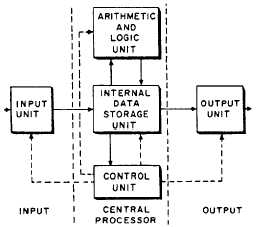the variety of tasks they can perform by the following
factors:
l The design of their central processors
. The variety of input/output devices used
l The programmer’s capability to develop a
numerical method for representing and solving the
problem
There are two basic types of digital computers—
the special-purpose and the general-purpose
computer.
Special-Purpose Digital Computers
Special-purpose digital computers are designed to
follow a specific set of instruction sequences that are
fixed at the time they are manufactured. To change
the operation of this type of computer, the actual
construction of the machine has to be altered.
General-Purpose Digital Computers
General-purpose digital computers follow
instruction sequences that are read into and stored in
memory prior to the calculation performance. This
type of computer operation can be altered by inputting
a different set of instructions. Since the operation of
general-purpose digital computers can be changed
with relative ease, as compared to special-purpose
computers, they provide a far greater usage flexibility.
DIGITAL COMPUTER OPERATION
Learning Objective: Recognize the operating
principles of a digital computer.
Each major section of the digital computer is
comprised of various electrical circuits. These circuits
include flip-flops (bistable devices), amplifiers, gates
(such as AND and OR gates), and passive memory
elements. These elements are organized into registers,
counters, and gates. Registers are a series of electronic
devices for temporary storage of a binary word.
Counters are a series of electronic devices that progress
through a specific binary sequence. The gates are used
to set a flip-flop or generate a times condition signal.
The computer manipulates binary numbers representing
numerical values or conditions. Devices to retain these
binary figures comprise the majority of the computer
registers, and each register has a distinct purpose or
function. Many operations require that the binary word
or data be transferred from one register to another. It is
possible for several different words to be transferred
simultaneously.
Gates are used to control the transfer of data
words from one register to another. These gates
consist of diode and resistor networks. The gate
circuit generates a signal to transfer the contents of
one register to another at a particular time if certain
conditions are met. For example, if the instruction
being executed is an add, and if one of the numbers
being added is a negative number, then the gate will
generate a command signal. If these conditions are
not met, the gate will not generate the command
signal.
Several gates in the computer are active only
during specific instructions, such as divide or
multiply, and then only during that particular
instruction. On the other hand, some gates are active
during several instructions, generating command
signals. In the design of a computer, each instruction
that the computer is to perform is very methodically
analyzed, and for each signal required, a gate is
designated to generate the signal.
The size of the registers determines the general
size of the computer. Not all registers in the computer
have the same word length. Some are determined by
the accuracy required, while others are determined by
the instruction word, number of addresses in the
memory, and various other parameters.
DIGITAL DATA PROCESSOR
Learning Objective:
Referring to various
schematic and block diagrams, recognize the
components of a digital data processor and
the function(s) of each.
Figure 8-1 is a functional block diagram of a
digital data processing set. Of the processes that take
place within a computer, the manipulation of data is
Figure 8-1.-Digital data processor block diagram.
8-3

